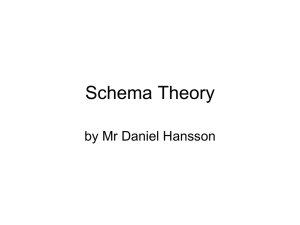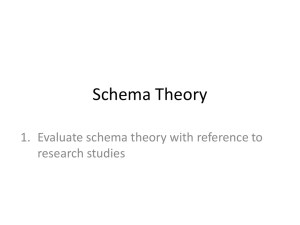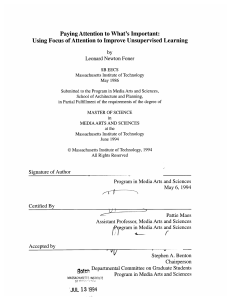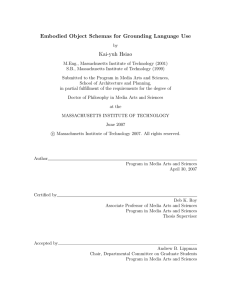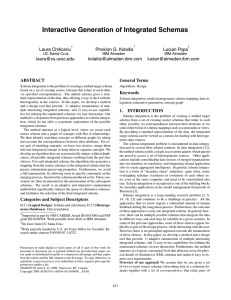Cognitive Level of Analysis OBJECTIVE: Evaluate Schema Theory
advertisement
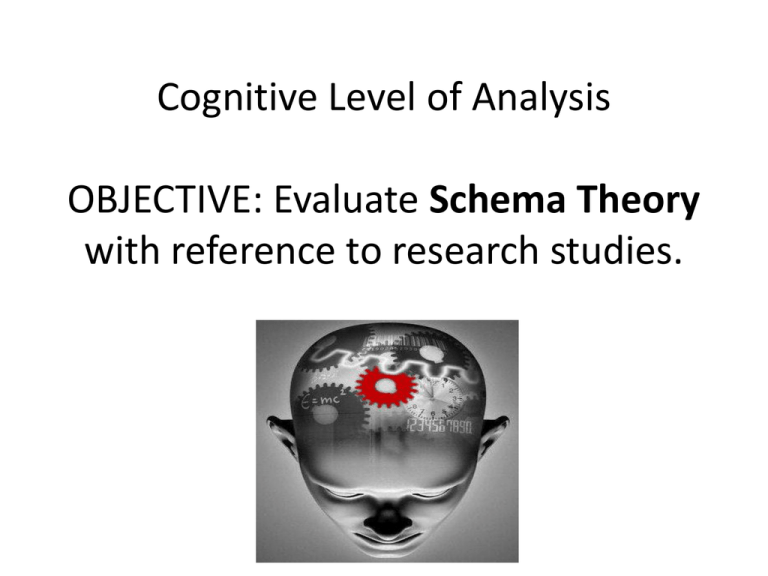
Cognitive Level of Analysis OBJECTIVE: Evaluate Schema Theory with reference to research studies. Beauty is in the Eye of the Beholder’s Schema • Cognitive process are influenced by social/cultural factors – Schema • Definition: a mental representation of knowledge that guides decisions/behaviors • Cultural/social influence may lead to distortions of schemas (e.g.. thin = beauty) • Self Schema: how we organize info about ourselves • Social Schema: how we organize info about groups (stereotypes) – Schema Theory (Bartlett) • Networks of knowledge, beliefs, expectations about particular aspects of the world • Experiences continually inform, change, influence our existing schemas and the formation of new ones • Research example: Bartlett and the War of Ghosts (1932) – AIM: to test the effects of schema on recall Bartlett’s Method • Subjects were separated into 2 groups – Serial reproduction • The first participant reads a story and reproduces it, this is read by the second participant who reproduces it for a third participant and so on until the seventh reproduction. – Repeated reproduction • The same participant contributes all seven reproductions, these reproductions are separated by intervals of 15 minutes. Bartlett’s Results • The two methods led to very similar findings – Serial Reproduction: the stories became shorter each time and there were distortions in the story. – These distortions made the story more understandable from the participants experiences and cultural background. – Things culturally unfamiliar to the participants were replaced with familiar ones. (Hunting seals to fishing). – Shows that schemas were used in recall. Evaluation of Bartlett • Strengths – Provides evidence that the way we remember depends on our prior knowledge in the form of schemas – Ecologically valid – Ethically sound • Weaknesses – – – – – Only used English participants. Different cultures may produce different results. Participants were not of the general population. His approach to research lacked objectivity. Was too casual as he simply asked for recall at various intervals (lack of control) Distortions • Schema distortions result when we have trouble making sense of, or filling in the missing bits of new information • Research Example: Turnbull’s study of the BaMbuti Tribe in Central Africa (1961) • The BaMbuti tribe lived in a densely forested region of Central Africa. • This environment greatly impacted their ability to perceive distance. • Turnbull found that the BaMbuti were not able to perceive objects beyond a distance of 150 feet (approx. 50 yards) by taking a young member of the tribe named Kengi out on the savannah. • From a ridge, Turnbull showed the Kengi animals far in the distance. • Kengi described the distant animals as “bugs” and was astonished when Turnbull drove him closer to the animals who naturally increased in size as the jeep got closer. Kengi even accused Turnbull of being a witchdoctor. • In reality, Kengi was unable to complete the perceptual rules of “Shape Constancy” and “Size Constancy”, something that we take for granted thanks to our environment. • Kengi could “see” the animals, but he was experiencing a schematic distortion. There was no previous experience to guide his new perceptions. Schemas and Memory • Anderson and Pichert (1978) H&C p. 72 • Bansford and Johnson (1972) – Aim: Identify stage(s) in processing where schemas exert their influence – Method: subjects in 3 groups heard a long speech • Group 1: No title, only story • Group 2:Title and told the story is about “washing clothes” pre-reading • Group 3: Title and told story is about “washing clothes” post-reading • Subjects asked to recall as much of story as possible • Results – Participants in the no title and title after conditions found the paragraph difficult to comprehend than the title before group. – The “title before” condition participants activated schematic knowledge about what is involved in washing clothes and aided understanding. Schemas and Stereotyping • McRae et al. (1994) – Aim: examine the effects of schema on stereotypes – Method: First, participants had to form impressions of a number of target persons described by name and 10 personality traits. • At the same time participants were also doing a comprehension test for which there were two conditions: – Half of participants were told the jobs of the target persons. – Half were not. • Results – Participants who relied on job stereotypes did perform better at both tasks. For example knowing that someone was a doctor elicited responses such as “caring, reliable, intelligent”. – Schemas can influence the formation of stereotypes. Research on Schemas and Gender • Martin and Halverson (1987) • Argued that children as young as 2 or 3 who have acquired basic gender identity start to form gender schemas, which consist of organized sets of beliefs about the sexes. • This is an in-group/out-group schema: organized around which toys/activities are “for boys” or “for girls”. • Supports formation of Own-gender schema : how to behave in gender stereotyped ways. • Martin and Halverson (1983) – Showed 5-6 year old children pictures of schema consistent and inconsistent activities. Schema inconsistent activities were often misremembered 1 week later. • Bradbard et al. (1986) – Boys and girls between ages 4-9 were shown gender neutral objects and told that some were boy objects and others were girl objects . – Results: children spent much more time playing with “gender appropriate” objects. – A week later the children remembered whether any given object was a “boy” or a “girl” object. Evaluation of Gender Schema Theories • + Helps explain why children’s gender role belief and attitudes change little after middle childhood. • + Focuses on child as being actively involved in making sense of the world in the light of its present knowledge. • -Theory emphasizes the role of the individual child in gender development and de-emphasizes the role of environmental/social/cultural factors. • -Likely the importance of schemas and other cognitive factors in determining behavior is exaggerated within theory. • - Doesn’t explain why gender schemas develop and take the form they do.


